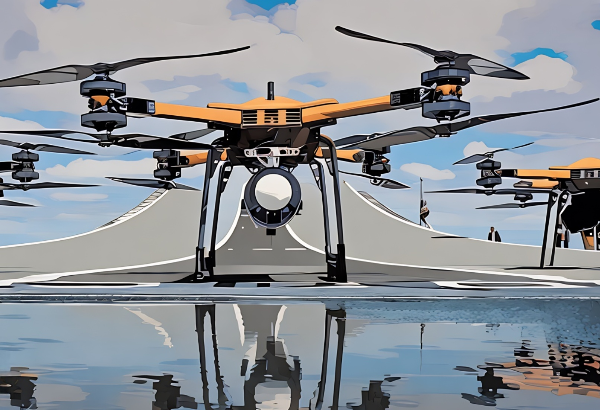As China’s cheap drones reshape war, the US risks being left behind

Let’s take a moment to revisit World War II–specifically, the year 1940.
It was a time when Britain, standing alone against the might of Nazi Germany and Fascist Italy, had no choice but to innovate or perish. Outnumbered and outgunned, the British managed a stunning naval victory that would alter the course of warfare.
Their weapon of choice was an aircraft carrier. The HMS Illustrious launched a daring strike against the Italian fleet, anchored in the harbor of Taranto. Using newly developed aircraft, the British disabled three Italian battleships and several other vessels–without the enemy ever catching a glimpse of their attackers.
The battle was swift, decisive, and, at least for the moment, a powerful demonstration of Britain’s naval supremacy.
But here’s the twist. Just over a year later, Winston Churchill’s faith in the old guard of naval power would prove disastrous. In 1941, he sent two of Britain’s prized warships–the battleship Prince of Wales and the battlecruiser Repulse–to deter a Japanese assault on Singapore.
These warships, the epitome of military might, were meant to project strength in the Pacific. But the British leadership, despite their victory at Taranto, failed to learn the most crucial lesson of modern warfare: that air power had fundamentally shifted the balance of naval power.
The result? Disaster. In December 1941, Japanese torpedo bombers, using a fleet of much smaller and faster aircraft, easily sank both ships. No longer were battleships the invincible titans of the sea.
In a brutal, almost poetic irony, the British had poured their resources into ships that could not withstand the forces of technological evolution they themselves had helped catalyze.
Churchill, ever the pragmatist, could hardly hide his shock. But the damage was done: the British fleet withdrew, abandoning Southeast Asia to the Japanese onslaught. The world had changed, and the proud battleship had been rendered obsolete by a new, nimble force: air power.
The moral of the story is painfully clear: technological revolutions do not wait for those in power to catch up. They sweep in, often without warning, and leave outdated ideologies and investments in their wake.
What happened to the battleships at Taranto and the Prince of Wales is the very same fate that can befall anyone–governments, corporations, or entire societies–that fails to recognize and adapt to disruptive innovations.
So fast forward to 2025. Have we learned the lesson of history, or are we about to see a modern Battle of Taranto unfold? History doesn’t repeat itself, but it does tend to rhyme–and if we’re not careful, we may be facing our own technological reckoning, unprepared and too late to pivot.

A new kind of
battlefield
For years, Russia has relied on its fleet of strategic bombers–some capable of carrying nuclear payloads–to launch cruise missiles at Ukraine from vast distances, out of reach of Ukrainian forces.
When Ukrainian drones successfully targeted these bombers on the ground, Russia simply moved them farther away, making them even harder to hit.
But the Ukrainians, in a masterstroke of ingenuity, adapted. They loaded small, plastic battery-powered quadcopters–no more sophisticated than the kind of toy drones you’d see kids flying in the park–into trucks and sent them across Russia, somehow evading detection.
Once near Russian airbases, these drones popped out of the trucks and began their mission: decimating Russia’s prized bombers and other aircraft parked on the tarmac.
How many bombers were destroyed remains unclear, but the results are undeniable: significant damage to one of Russia’s most important and costly military assets, taken out by little more than toy-grade drones.
In an instant, the landscape of modern warfare had changed. The costliest, most powerful machines of destruction–some worth hundreds of millions of dollars–were dismantled by nothing more than cheap, battery-powered toys.
Now consider this: The United States military, despite its superior strength, is built on much the same model as Russia's. It relies on a series of expensive, heavy “platforms”--F-22 stealth fighters, Ford-class aircraft carriers, M1 Abrams tanks–all of which come with exorbitant price tags.
An F-22 costs $350 million, a Ford-class carrier $13 billion, and an M1 Abrams tank more than $4 million. These are the behemoths that define modern military power.
But what happens when these colossal, multi-billion-dollar machines become vulnerable to something as cheap and ubiquitous as a Chinese-made drone? Every time a cheap, plastic drone destroys a piece of American hardware, the cost isn't just monetary—it’s the strategic advantage that disappears with it.
And that doesn’t even factor in the human cost of the soldiers inside when their vehicles are taken out.
What makes this threat even more dire is the fact that the U.S., like Russia, has limited defense manufacturing capacity. In a prolonged conflict, such as over Taiwan or the South China Sea, America wouldn’t simply be fighting an enemy–it would be racing against time to replace lost assets it can’t quickly produce.

Threats from unthinkable places
The world has seen this before. Just like Japan in World War II, or Russia now, the traditional powerhouses of the military might be facing an existential vulnerability.
Military planners everywhere are now scrambling to defend against the type of raid that Ukraine just executed with stunning success. As container ships from China continue to flood American ports every day, military strategists are starting to realize that the real threat might not come from a nation's army, but from an entirely new kind of weapon: a drone that costs less than a laptop.
Every day, container ships arrive at American ports, packed with thousands of containers from all corners of the globe. Imagine, for a moment, a hundred of these containers suddenly disgorging swarms of drones–small, cheap, battery-powered, and devastating.
In mere minutes, these drones could obliterate a significant portion of America’s multi-trillion-dollar Air Force and Navy. The question is no longer if this could happen, but how the U.S. would defend itself.
The threat is undeniable, and the countermeasures–hardened aircraft shelters, air defense systems like guns, jammers, electromagnetic pulses, laser cannons, and drone interceptors–are already being discussed.
Improved surveillance of incoming shipments will be essential. But no matter how much money the U.S. throws at these defenses, the emergence of low-cost drones has irrevocably changed the nature of warfare, transforming the entire globe into a potential battleground.
The balance of power, it seems, has shifted overnight.
The problem with the US is that despite being the birthplace of drone technology, the U.S. military’s current drone arsenal is far from cutting-edge. Take the MQ-9 Reaper, for example–a massive, lumbering drone that costs $33 million each.
While the Reaper has its uses, it is far from the nimble, inexpensive devices that have revolutionized warfare in places like Ukraine. During the recent conflict with the Houthis, the U.S. lost at least seven Reaper drones–and possibly as many as twenty–at the hands of a ragtag Yemeni militia.
The U.S. military only has a few hundred of these drones. Contrast this with the thousands of cheaper, more efficient drones on the market today.

Swift and nimble warfronts
The drones that took out Russian bombers in Ukraine weren’t anything like the MQ-9 Reapers. These were FPV drones–small, battery-powered plastic copters equipped with explosives.
They cost just a few hundred to a few thousand dollars each, depending on the model. Ukraine is churning out thousands of these drones daily, and it expects to produce more than 10,000 in the near future. The twist? Most of the drones or their parts are sourced from China.
Why the flood of drones? Because FPV drones aren’t just for long-range surprise attacks. They are quickly replacing nearly every other weapon on the battlefield. In Ukraine, these small, cheap drones have proven to be devastatingly effective against tanks–yes, even against America’s best models.
FPV drones now account for an estimated 70% of battlefield casualties, surpassing artillery, the traditional “god of war.” They are fast, flexible, and deadly.
To put this into perspective, drones are rapidly becoming the dominant force on the modern battlefield. They can take out tanks, destroy air defenses, and assassinate high-value targets with precision.
And all of this is happening with drones that cost mere fractions of what the U.S. spends on its flagship military hardware.
Military planners around the globe meanwhile are taking note. Taiwan, bracing for a potential conflict with China, is investing heavily in mass-produced drones. Israel, in the midst of the war in Gaza, has recalibrated its Iron Dome air defense system to account for the rapidly evolving threat of maneuverable drones–once one of its biggest blind spots.
Meanwhile, European governments, engaged in their largest rearmament effort since the Cold War, have prioritized both drones and counter-drone technologies. Even the U.S. Pentagon, traditionally the patron of high-tech, high-cost drones sourced from major arms contractors, is shifting its focus to cheaper, more efficient drones designed by startups and deployed en masse.
The key innovation? Small, lightweight drones with multiple rotors–first-person-view (FPV) drones. These drones are typically controlled in real time through a video feed, allowing operators to “see” through an onboard camera with the help of electronic goggles, enabling them to fly well beyond the operator's line of sight.
These machines are now ubiquitous on battlefields, and social media is flooded with footage of them closing in on enemy troops, armored personnel carriers, missile batteries, and command posts.
The moment of impact–when the camera feed goes to static–is both chilling and revolutionary.

The era of drone warfare
Other FPV drones are being used to drop grenade-sized explosives on targets, and, unlike traditional munitions, many of these drones can be reused if they return safely. In Ukraine, this has led to the rapid mass production of drones, many of which are built with parts purchased online–though “online” here is a euphemism.
The bulk of the components that make up these drones–specifically the injection-molded plastic parts, computer chips, electric motors, and lithium-ion batteries–are sourced directly from China.
This has laid bare a critical vulnerability for the U.S. and its allies. Despite still being capable of manufacturing trailing-edge computer chips, the U.S. is dependent on China for much of the rest of the supply chain.
China dominates global injection molding, producing roughly 82% of the world’s injection-molded plastic parts. Meanwhile, the U.S. has done little to restore its own capacity in this critical manufacturing area.
To make matters worse, Trump-era tariffs–if ever fully implemented–are poised to further damage the U.S. injection molding industry by cutting American companies off from the specialized equipment they need.
The implications are clear: The cheap, mass-produced drones that are transforming warfare are built on a supply chain largely controlled by China.
The first piece of this new war puzzle is: electric motors. China doesn't just make the most motors; it manufactures the magnets that power them. An electric motor is essentially just magnets, and China controls the lion's share of rare earths, the minerals essential for producing those magnets.
While the rest of the world scrambles to catch up and build its own magnet production capacity, China’s dominance will remain unchallenged for at least the next decade. That’s because rare earths, the vital materials for magnets, are overwhelmingly mined and processed in China.
Recently, China slapped export controls on these rare earths, triggering chaos in multiple U.S. industries, and likely contributing to Trump’s decision to halt his tariffs. America’s attempts to mine and refine these critical materials have so far fallen woefully short, and that’s a story worth exploring in another piece.
In 2022, China held a staggering 77% of the global battery manufacturing capacity, and projections for 2030 suggest that even with the Biden administration’s subsidies for U.S. battery factories, China’s lead will remain nearly insurmountable.
Without a robust domestic battery production capacity, the U.S. will be unable to produce the drones essential for modern combat. The simple truth is this: If America cannot manufacture the small, efficient, battery-powered FPV drones that are revolutionizing warfare, it will be at a severe disadvantage in a future conflict, particularly with China.
Just as the British Navy in 1941 failed to recognize the advent of air power until it was too late, the U.S. risks becoming irrelevant in a world where drones and battery-powered technologies dominate warfare.
The shift is happening, and America is at risk of missing the boat entirely–unprepared, outgunned, and vulnerable.
—
Md Sazzad Amin is an entrepreneur and an armchair geopolitical analyst

